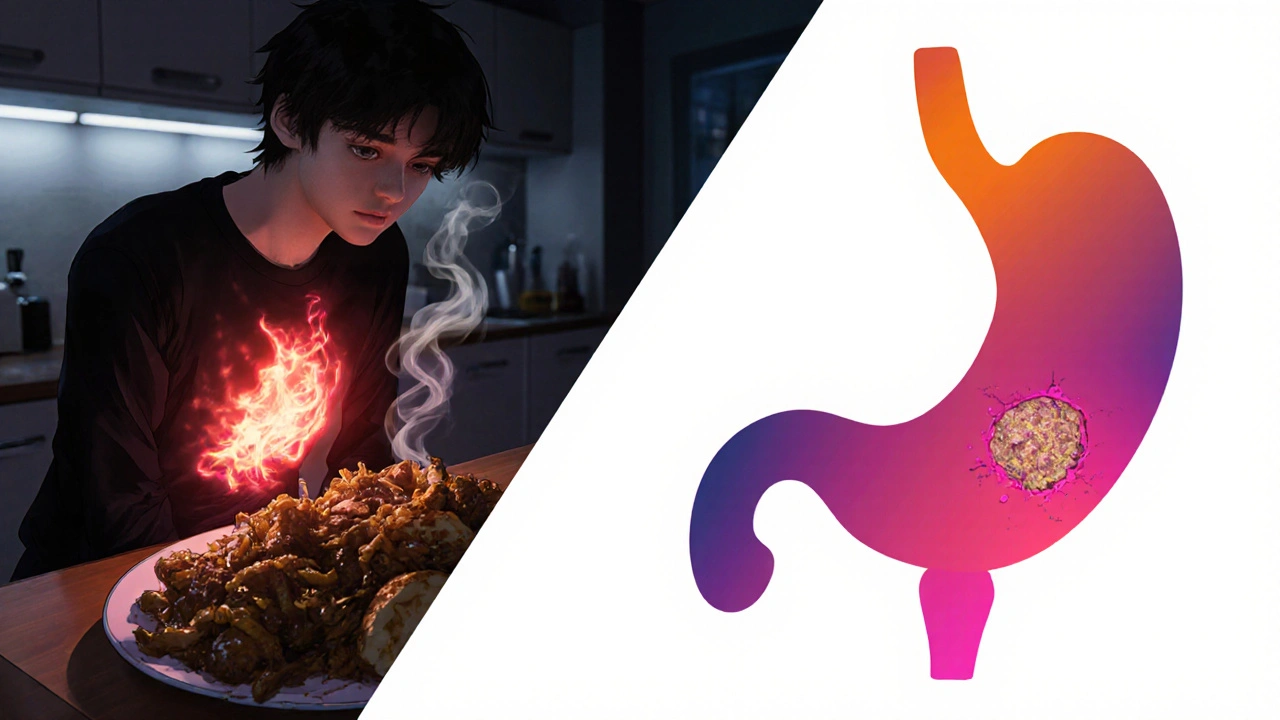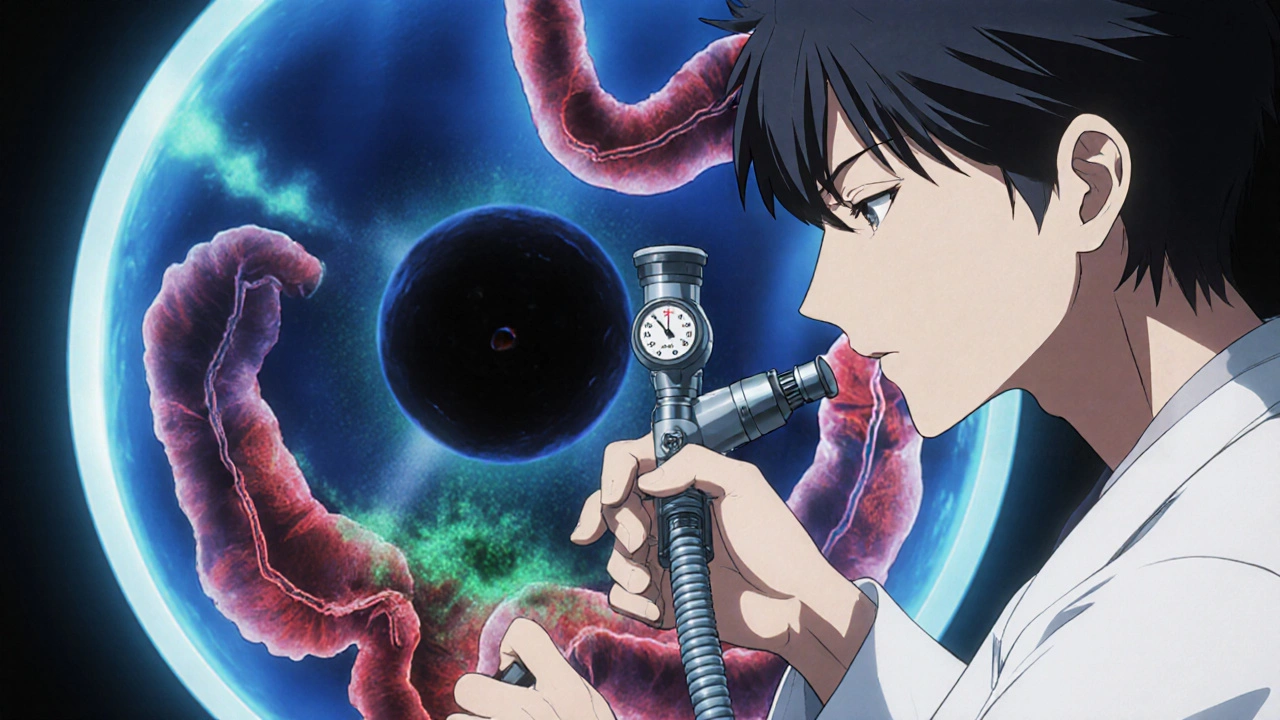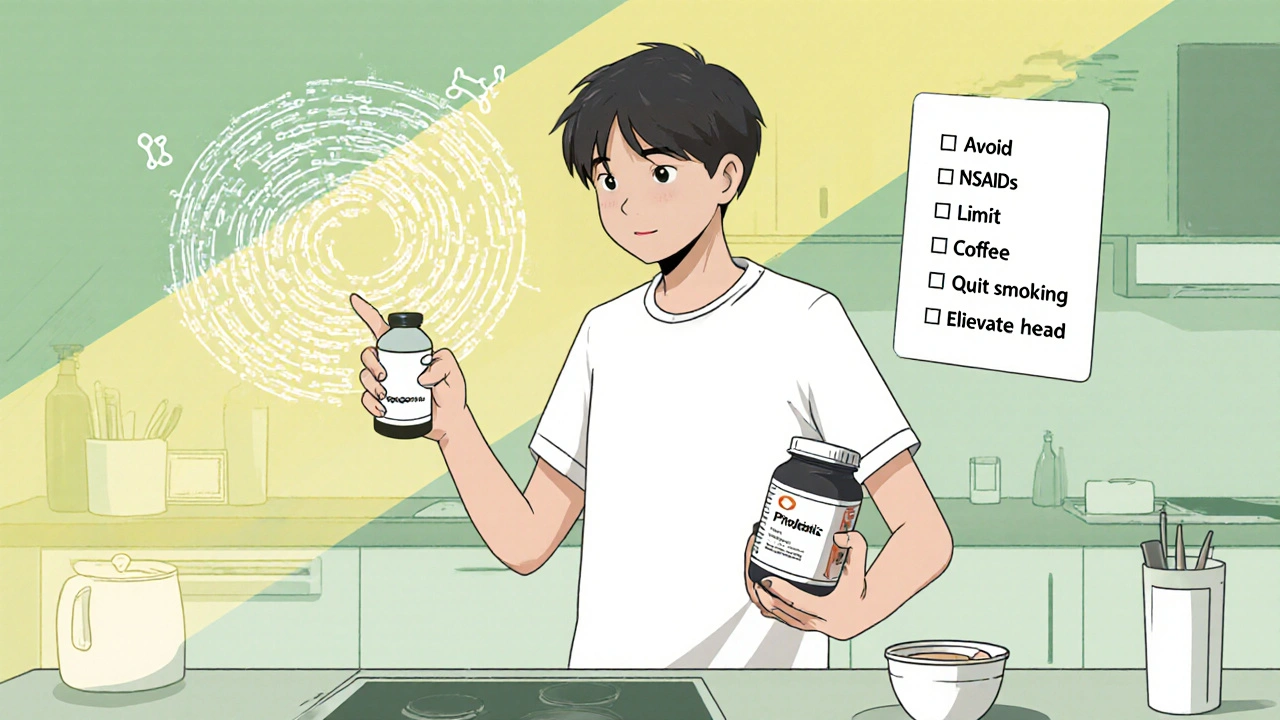Stomach Ulcer vs Heartburn: How They're Linked and What It Means
 Oct, 18 2025
Oct, 18 2025
Stomach Ulcer vs Heartburn Symptom Checker
Answer a few questions to understand your symptoms
This tool helps identify whether your discomfort is more likely related to a stomach ulcer or heartburn based on your symptoms and lifestyle factors. Note: This is not a medical diagnosis.
Your Symptom Analysis
Key contributing factors:
Next Steps
Ever felt that burning sensation after a big meal and wondered whether it’s just heartburn or something more serious like a stomach ulcer? You’re not alone. Many people mix up the two because they share similar triggers and discomfort, but the underlying causes and health risks differ. This guide breaks down what each condition really is, how they intersect, and what steps you can take to ease the pain and protect your digestive system.
What Is a Stomach Ulcer?
Stomach ulcer is a sore that forms on the lining of the stomach, part of a broader group called peptic ulcer disease. The ulcer creates a break in the protective mucus layer, exposing the underlying tissue to stomach acid. Common symptoms include gnawing pain that often worsens on an empty stomach, nausea, bloating, and in severe cases, vomiting blood.
Two main culprits drive ulcer formation: Helicobacter pylori (a bacterium that inflames the stomach lining) and regular use of non‑steroidal anti‑inflammatory drugs (NSAIDs) such as ibuprofen or aspirin. When either factor weakens the mucus barrier, acid can erode the tissue, leading to a painful sore.
What Is Heartburn?
Heartburn is the uncomfortable, burning feeling that rises from the stomach up into the chest and sometimes the throat. It’s a classic symptom of gastro‑esophageal reflux disease (GERD), where stomach acid flows backward into the esophagus-the tube that connects your mouth to your stomach.
Unlike an ulcer, heartburn typically doesn’t involve a physical sore in the stomach lining. Instead, it’s the irritation of the esophageal lining by acidic contents. Triggers include large meals, fatty or spicy foods, caffeine, alcohol, and lying down soon after eating.
How the Two Conditions Overlap
Both stomach ulcers and heartburn share the same enemy: excess gastric acid. When the stomach produces too much acid, it can both erode the stomach lining (causing an ulcer) and push acid upward into the esophagus (causing heartburn). This overlap explains why many patients report both symptoms simultaneously.
Key shared risk factors include:
- Frequent use of NSAIDs, which thin the mucus barrier and also relax the lower esophageal sphincter, making reflux more likely.
- Infection with H. pylori, which increases acid production and weakens stomach defenses.
- Lifestyle habits such as smoking, high‑fat diets, and excessive caffeine intake.
Because the triggers are similar, treating one condition often helps the other. Reducing acid, avoiding irritants, and healing the stomach lining can lessen both ulcer pain and heartburn episodes.

Common Triggers and Lifestyle Factors
If you’re battling either issue, look at these everyday habits that can tip the balance toward more acid:
- Medications: Regular aspirin, ibuprofen, naproxen, or even certain prescription drugs can damage the stomach lining.
- Alcohol and Caffeine: Both relax the lower esophageal sphincter, allowing acid to reflux, and can increase stomach acid output.
- Spicy and Fatty Foods: These can delay stomach emptying, keeping acid in contact with the lining longer.
- Smoking: Nicotine reduces mucus production and impairs healing.
- Stress: While stress alone doesn’t cause ulcers, it can worsen symptoms by increasing acid secretion.
Making small changes-like swapping coffee for herbal tea, using acetaminophen instead of ibuprofen for occasional pain, and eating smaller, more frequent meals-can dramatically reduce the frequency of both ulcer flare‑ups and heartburn.
Diagnosis - How Doctors Tell Them Apart
Because the symptoms overlap, doctors rely on a combination of patient history, physical exams, and specific tests:
- Endoscopy: A tiny camera is passed down the throat to directly view the stomach lining. Ulcers appear as clear, round sores, while the esophagus may show signs of inflammation from reflux.
- Urea Breath or Stool Test: Detects the presence of H. pylori. A positive result points toward ulcer‑related causes.
- pH Monitoring: A thin probe measures acid exposure in the esophagus over 24 hours, confirming GERD‑related heartburn.
- Blood Tests: Check for anemia (a sign of bleeding ulcer) and rule out other conditions.
Accurate diagnosis is crucial because treatment for an ulcer caused by H. pylori differs from heartburn managed solely with lifestyle changes.
Treatment Options - Shared and Separate Approaches
| Aspect | Stomach Ulcer | Heartburn (GERD) |
|---|---|---|
| Primary Cause | H. pylori infection or NSAID use | Acid reflux due to weak lower esophageal sphincter |
| Typical Pain | Gnawing, worsens on empty stomach | Burning sensation rising to chest/throat |
| Key Diagnostic Test | Endoscopy, urea breath test | pH monitoring, endoscopy (optional) |
| First‑Line Medication | Proton pump inhibitors (PPIs) + antibiotics if H. pylori positive | Antacids, H2 blockers, PPIs for severe cases |
| Lifestyle Changes | Avoid NSAIDs, limit alcohol, quit smoking | Elevate head of bed, eat smaller meals, avoid trigger foods |
| Potential Complications | Bleeding, perforation, gastric obstruction | Esophagitis, Barrett’s esophagus, strictures |
Both conditions benefit from Proton Pump Inhibitors (PPIs) because they slash acid production. However, ulcer treatment often adds a short course of antibiotics (typically clarithromycin, amoxicillin, and a PPI) to eradicate H. pylori. For heartburn, over‑the‑counter antacids like calcium carbonate can provide quick relief, while lifestyle tweaks play a larger role in long‑term control.

When to Seek Medical Help
Most mild episodes can be managed at home, but certain signs demand a doctor’s attention:
- Vomiting blood or material that looks like coffee grounds. \n
- Black, tarry stools (a sign of digested blood).
- Persistent pain that doesn’t improve after 2 weeks of OTC treatment.
- Difficulty swallowing, unexplained weight loss, or chronic cough.
- Sudden, severe chest pain that radiates to the arm or jaw (rule out cardiac issues).
Early intervention can prevent ulcer perforation and reduce the risk of Barrett’s esophagus, a pre‑cancerous condition linked to long‑standing GERD.
Quick Checklist for Managing Symptoms
- Identify your personal triggers-keep a simple food‑symptom diary for 2 weeks.
- Switch from NSAIDs to acetaminophen for occasional pain.
- Take PPIs as prescribed, not just when you feel pain.
- Eat meals at least 3 hours before bedtime; elevate the head of your bed by 6‑8 inches.
- Quit smoking and limit alcohol to no more than one drink per day.
- Schedule a medical appointment if symptoms persist beyond 14 days or if you notice warning signs.
Frequently Asked Questions
Can heartburn cause a stomach ulcer?
Heartburn itself doesn’t create a sore in the stomach lining, but the excess acid that causes reflux can also irritate the stomach wall. If you have frequent reflux and also take NSAIDs, the combined effect can increase ulcer risk.
How long does it take for an ulcer to heal?
With proper medication and avoidance of irritants, most uncomplicated ulcers heal in 4‑8 weeks. Follow‑up endoscopy may be recommended for larger or persistent sores.
Are antacids enough for long‑term heartburn control?
Antacids neutralize acid quickly but don’t stop production. For chronic GERD, doctors usually recommend H2 blockers or PPIs combined with lifestyle changes for lasting relief.
What tests confirm H. pylori infection?
The most common are the urea breath test, stool antigen test, and endoscopic biopsy. Blood antibody tests are less reliable because they can stay positive after the infection clears.
Can I take a probiotic while treating an ulcer?
Yes, probiotics can help restore gut balance, especially after a course of antibiotics for H. pylori. Choose strains like Lactobacillus rhamnosus or Saccharomyces boulardii for best results.
Understanding the link between stomach ulcers and heartburn equips you to spot warning signs early, choose the right treatment, and make lifestyle tweaks that keep both conditions at bay. If you notice persistent pain, blood in your stool, or any of the red‑flag symptoms, don’t wait-reach out to a healthcare professional for a proper evaluation.


Matthew Miller
October 18, 2025 AT 13:47Hey folks, if you’ve been wrestling with that gnawing pain after a big dinner, think of your stomach like a furnace - you can stoke it with the right fuel or douse it with cool water. Swap that extra‑large, greasy steak for a balanced plate of lean protein, whole grains, and veggies, and you’ll notice the burn melt away faster than a snowflake in July. Keep a food‑symptom diary; it’s the secret weapon that turns mystery into mastery.
Stay pumped, stay proactive, and you’ll outsmart both ulcer and heartburn before they get a foothold!
Alex Lineses
October 19, 2025 AT 12:00Let’s break this down with some clinical terminology: peptic ulcer disease (PUD) often co‑exists with gastro‑oesophageal reflux disease (GERD) due to overlapping pathophysiological mechanisms, namely hypersecretion of gastric acid and compromised mucosal defenses. By implementing a multimodal therapeutic regimen-PPIs for acid suppression, H. pylori eradication protocols, and behavioural modifications-you address both the etiological vector and the symptomatology. Remember, adherence to the antibiotic cocktail is crucial to prevent resistance, and lifestyle engineering (weight management, dietary timing) serves as the adjunctive scaffold for long‑term remission.
Brian Van Horne
October 20, 2025 AT 10:13In essence, the ulcer attacks the stomach lining while heartburn assaults the esophagus; both stem from acid dysregulation.
Janet Morales
October 21, 2025 AT 08:27Oh great, another post telling us to ditch NSAIDs and sip herbal tea-like the world’s problems vanish with a herbal infusion! As if the acid‑producing beast inside our gut magically calms because we switched from ibuprofen to a yoga pose. The truth? Your stress levels, the night‑shift schedule, and that secret stash of coffee you hide in the pantry are the real culprits, not just the occasional naproxen. Stop buying the hype, diagnose your habits, and confront the hidden villains.
Albert Fernàndez Chacón
October 22, 2025 AT 06:40I totally get how confusing it can be when the burning feels like it’s coming from both the chest and the belly. Listening to your body and noting when the pain hits after certain meals can really help you tell the difference. If you’re not sure, a quick chat with your doctor about a possible H. pylori test or an endoscopy might bring some peace of mind. You’re not alone in this.
Mike Hamilton
October 23, 2025 AT 04:53The relationship between ulcer and heartburn is a bit like a cosmic dance, a perpetual tango between creation and destruction within the gastric microcosm. When we consider the stomach as a crucible of alchemical transformation, the acid becomes both a catalyst and a corrosive force, shaping and eroding in equal measure. H. pylori, that microscopic trickster, infiltrates the mucosal citadel, sowing discord and inviting the acid to feast upon weakened tissue. Simultaneously, the esophageal sphincter, that humble gatekeeper, may falter under the weight of modern lifestyles-late-night feasts, caffeine storms, and nicotine haze-allowing the acid to surge upward like an overflowing river. This overflow, in turn, whispers back to the stomach, amplifying acid secretion in a feedback loop that feels almost predestined. Yet, the human agency, our capacity for mindful choice, can interrupt this cycle. By embracing dietary humility-choosing modest portions over gigantic feasts-we honor the balance of gastric chemistry. By opting for acetaminophen over ibuprofen when pain strikes, we spare the mucosal armor. By elevating our heads during slumber, we grant the sphincter a mechanical advantage, curbing the nocturnal reflux tidal wave. Philosophically, we are reminded that the body is not a passive vessel but an interactive system, responsive to both internal microorganisms and external habits. In the grand tapestry of health, the ulcer and heartburn threads are interwoven, each tugging at the other, and our conscious actions can re‑weave that pattern into a more harmonious design. Embrace the wisdom of patience, for ulcers typically mend within six to eight weeks under proper care, and heartburn can be tamed with sustained lifestyle stewardship. Let this knowledge be a lantern guiding you through the fog of discomfort toward a horizon of relief.
Liberty Moneybomb
October 24, 2025 AT 03:07What if I told you the “acid‑neutralizing” meds are just a smokescreen, a way for big pharma to keep us dependent while they hide the real cure-dietary autonomy? They don’t want you to know that simple lifestyle swaps can shut down the ulcer‑heartburn link permanently. Wake up, read the labels, and stop swallowing their sugar‑coated lies.
Joe Moore
October 25, 2025 AT 01:20Yo man the doc says it’s H pylori but i bet the gov is seeding the germs in our water to keep us sick lol
Emma Williams
October 25, 2025 AT 23:33Thanks for the clear rundown really helpful I’ll start tracking my meals and cut back on coffee
Rajesh Singh
October 26, 2025 AT 20:47It is a moral imperative to treat our bodies with respect; ingesting endless cups of caffeinated poison while ignoring the insidious H. pylori infestation is tantamount to self‑sabotage. We have the knowledge, the tools, the very antibiotics and dietary guidance-yet many choose the path of convenience, fueling the very fire that devours their stomach lining. Let us rise above complacency, champion preventive care, and deny the acid overlords their reign.
Drew Waggoner
October 27, 2025 AT 19:00Stop the pain now.
Norman Adams
October 28, 2025 AT 17:13Ah yes, because nothing says “I’m an educated adult” like popping a PPI every morning while simultaneously devouring a pepper‑laden cheeseburger at midnight. Such nuanced self‑care truly showcases our mastery over digestive physiology.
Margaret pope
October 29, 2025 AT 15:27Remember each small change adds up you don’t have to overhaul everything overnight just start with swapping soda for water and see how you feel soon enough you’ll notice big improvements